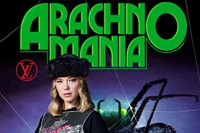The Collier Schorr-shot Pre-Fall 2020 campaign imagines 1970s-style horror and sci-fi titles with cover stars including Léa Seydoux, Robyn and Chloë Grace Moretz
Louis Vuitton’s latest campaign, released yesterday, pays homage to the campy cover art of 1970s pulp fiction novels. Featuring a raft of stars, photographed by AnOther Magazine contributor Collier Schorr – from musicians Robyn and Jaden Smith to actresses Stacy Martin and Angelica Ross, longtime friends of the house Alicia Vikander and Jennifer Connelly, and former AnOther cover stars Léa Seydoux and Chloë Grace Moretz – the faux horror, fantasy and sci-fi titles include The Devil’s Mansion, The Haunted Garden and Arachno-Mania. “Fashion is a novel,” the house says. “And the Pre-Fall 2020 collection embarks on a narrative journey where the garments tell their own tales.”
“William Peter Blatty, who wrote The Exorcist, gave us the rights to print the cover of the book [on pieces in the collection]. It started there,” Nicolas Ghesquière told American Vogue of the collection, in which the idea for the campaign came first, and the clothing second. “It’s such a great symbol for me to use a fiction and incorporate it into an outfit. I thought, what’s the reverse? To use the fiction as the illustration of the fashion. It’s a kind of a mirror effect in this action of representing them all in these different characters.”
The Pre-Fall collection takes inspiration from the 1970s – The Exorcist was published in 1971, and the cover art features on T-shirts here – with shearling outerwear, preppy monogrammed sportswear and poet-sleeved dresses and blouses, edged with broderie anglaise. In typical Ghesquière manner there are unexpected juxtapositions, too: looks might be accessorised with futuristic moon boots or jewellery evocative of Victorian cameos; while hybrid garments – like skirts in opposing racer-style leathers and houndstooth – clash sportswear and tailoring.
“This meeting of periods, stylistic movements and anachronistic combinations brings to life a rich cast of costumes,” says the house. “In such a ‘wearable library’, each outfit writes its own chapter made up of romantic monologues. Peculiar dialogues between stylistic rebellion and fine craftsmanship.”







